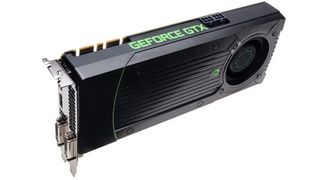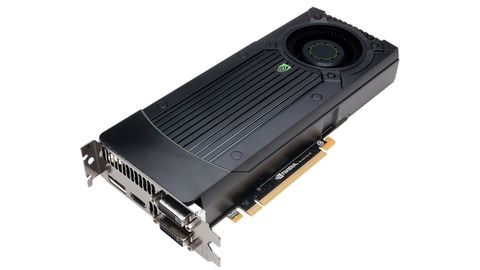Why you can trust TechRadar
The performance of the Nvidia GTX 670 should come as no surprise considering it's got pretty much all the goodness of the top-end GeForce GTX 680.
With only a single SMX module missing from the make up of the GK104 GPU that powers both graphics cards, the GTX 670 has only lost 192 CUDA cores and still retains 1,344 of them.
That means that it's only fractionally short of pace compared to the GTX 680 big brother.
The fact Nvidia has also seen fit to stuff a full 2GB of seriously fast (6GHz) GDDR5 memory onto the PCB, the self same stuff backing up the GTX 680, serves to keep things going at full-fat resolutions too.
This then is a card that's still more than capable of keeping your 30-inch panel fed with pretty pixels.
You can though see why Nvidia has chosen to hold the GTX 670 back a few months – if both the top Kepler cards (crazy-powerful, dual-GPU GTX 690 notwithstanding) had been released at the same time there would have been some fisticuffs between the two of them.
With an expected £100/$100 gap between the two cards there's not a lot more performance you're getting with the GTX 680 over the GTX 670.
It's a scant few frames per second at best.

That only means good things for our GTX 670, and even more so when compared with the AMD-shaped competition.
Throughout all the pre-release briefings Nvidia has been talking about going head-to-head with the AMD Radeon HD 7950, but that is only in price terms.
The real performance comparison has to be with AMD's current top card, the AMD Radeon HD 7970. And that comparison isn't particularly favourable towards the Texans.
The HD 7970 has dropped considerably in price in recent times, to the point where it's now only £60/$80 more expensive than the HD 7950, which still makes it pricier than the GTX 670.
And on balance it's pretty level.
In some benchmarks the Nvidia GTX 670 takes the lead and in others the AMD HD 7970 has the edge. It's only in Shogun 2 though that the difference is particularly pronounced, by almost 20 frames per second.
That is the exception with the competition being mighty close in everything else.
As with the GTX 680 the overclocking performance of this Kepler Nvidia GTX 670 is mighty impressive. Nvidia may be limiting the base clock to 915MHz out of the reference box, but it will happily offset much higher.
Our reference board was running stably with a 130MHz offset, which gave us regular gaming boost clocks of around 1,215MHz.
And all that with a still rather healthy temperature too.
We did have to crank the fan up to 60% for that, but even that didn't give offensive noise levels.
Indeed at that sort of speeds the noise was easily on par with the competing AMD Radeon HD 7970.

